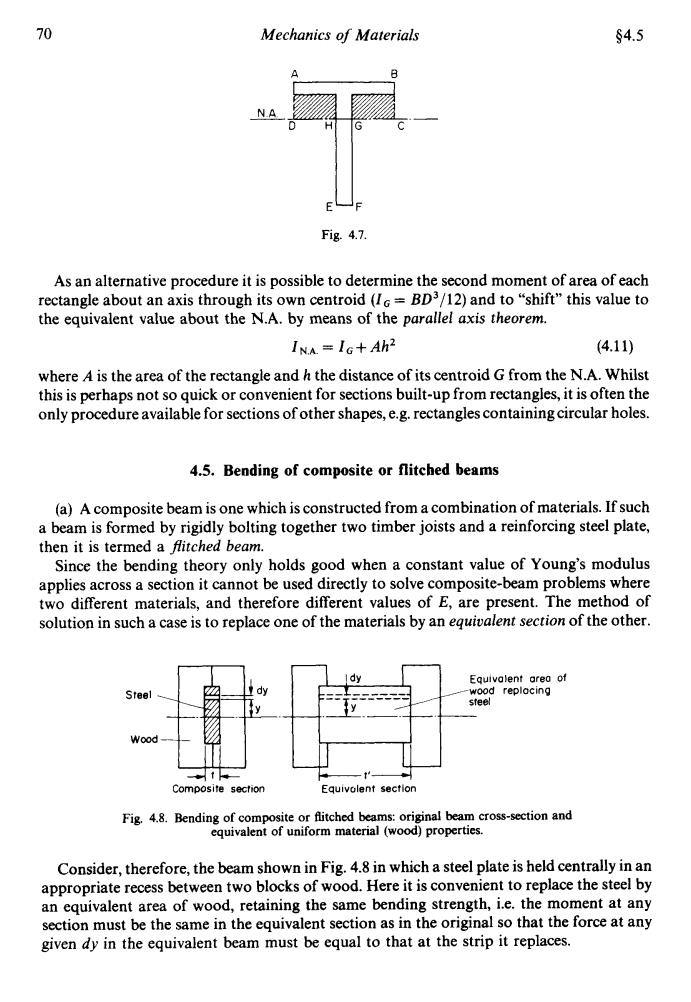正在加载图片...

70 Mechanics of Materials §4.5 NA Fig.4.7. As an alternative procedure it is possible to determine the second moment of area of each rectangle about an axis through its own centroid (I=BD3/12)and to"shift"this value to the equivalent value about the N.A.by means of the parallel axis theorem. INA=IG+Ah2 (4.11) where A is the area of the rectangle and h the distance of its centroid G from the N.A.Whilst this is perhaps not so quick or convenient for sections built-up from rectangles,it is often the only procedure available for sections of other shapes,e.g.rectangles containing circular holes. 4.5.Bending of composite or flitched beams (a)A composite beam is one which is constructed from a combination of materials.If such a beam is formed by rigidly bolting together two timber joists and a reinforcing steel plate, then it is termed a flitched beam. Since the bending theory only holds good when a constant value of Young's modulus applies across a section it cannot be used directly to solve composite-beam problems where two different materials,and therefore different values of E,are present.The method of solution in such a case is to replace one of the materials by an equivalent section of the other. Equivalent areo of Steel wood replocing steel Wood Composite section Equivolent section Fig.4.8.Bending of composite or flitched beams:original beam cross-section and equivalent of uniform material (wood)properties. Consider,therefore,the beam shown in Fig.4.8 in which a steel plate is held centrally in an appropriate recess between two blocks of wood.Here it is convenient to replace the steel by an equivalent area of wood,retaining the same bending strength,i.e.the moment at any section must be the same in the equivalent section as in the original so that the force at any given dy in the equivalent beam must be equal to that at the strip it replaces.70 Mechanics of Materials $4.5 EF U Fig. 4.1. As an alternative procedure it is possible to determine the second moment of area of each rectangle about an axis through its own centroid (I, = 8D3/12) and to “shift” this value to the equivalent value about the N.A. by means of the parallel axis theorem. IN.A. = IG+ Ah2 where A is the area of the rectangle and h the distance of its centroid G from the N.A. Whilst this is perhaps not so quick or convenient for sections built-up from rectangles, it is often the only procedure available for sections of other shapes, e.g. rectangles containing circular holes. (4.1 1) 4.5. Bending of composite or flitcbed beams (a) A composite beam is one which is constructed from a combination of materials. If such a beam is hrmed by rigidly bolting together two timber joists and a reinforcing steel plate, then it is termed a Pitched beam. Since the bending theory only holds good when a constant value of Young’s modulus applies across a section it cannot be used directly to solve composite-beam problems where two different materials, and therefore different values of E, are present. The method of solution in such a case is to replace one of the materials by an equivalent section of the other. Steel Wood Equivalent ore0 of wood repiocing steel Composite section Equivuient section Fig. 4.8. Bending of composite or flitched beams: original beam cross-section and equivalent of uniform material (wood) properties. Consider, therefore, the beam shown in Fig. 4.8 in which a steel plate is held centrally in an appropriate recess between two blocks of wood. Here it is convenient to replace the steel by an equivalent area of wood, retaining the same bending strength, i.e. the moment at any section must be the same in the equivalent section as in the original so that the force at any given dy in the equivalent beam must be equal to that at the strip it replaces